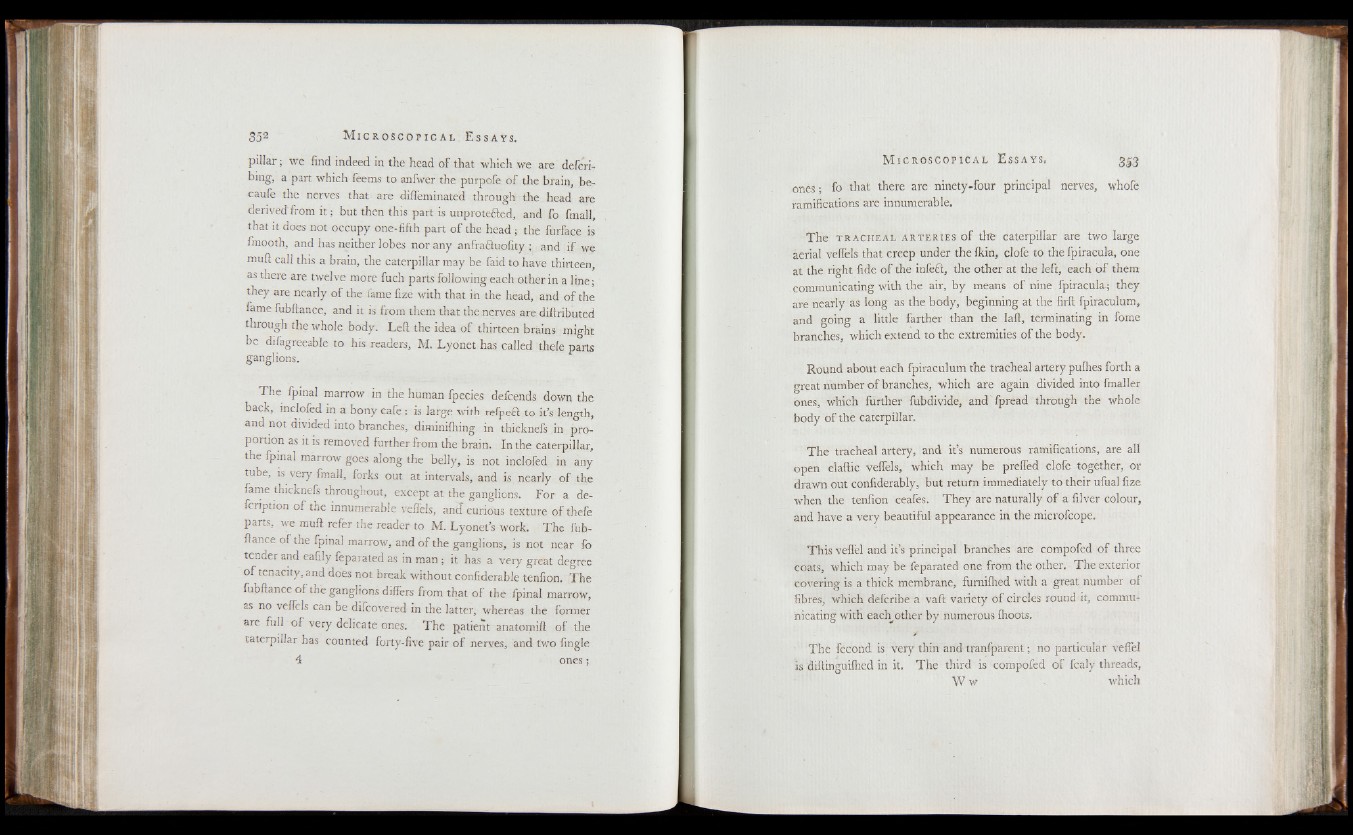
pillar; we find indeed in the head o f that which we are defending
» a part which feems to anfwer the purpofe o f the brain, be-
caufe the nerves that are diffeminated through the head are
derived from i t ; but then this part is unprote&ed, and fo final!,
that it does not occupy one-fifth part o f the head ; the furface is
fmooth, and has neither lobes nor any anfraftuofity ; and if we
muft call this a brain, the caterpillar may be faid to have thirteen,
as there are twelve more fuch parts following each other in a line;
they are nearly o f the fame fize with that in the head, and o f the
fame fubftance, and it is from them that the nerves are diftributed
through the whole body. Left the idea o f thirteen brains might
be difagreeable to his readers, M. Lyonet has called thele parts
ganglions.
The fpinal marrow in the human fpecies defcends down the
back, inclofed in a bony cafe ; is large with refpeft to it’s length,
and not divided into branches, diminilhing in thicknefs in proportion
as it is removed further from the brain. In the caterpillar,
the fpinal marrow goes along the belly, is not inclofed in any
tube, is very fmall, forks out at intervals, and is nearly o f the
fame thicknefs throughout, except at the ganglions. For a de-
fcription o f the innumerable veflels, and curious texture of thefe
parts, we muft refer the reader to M. Lyonet’s work. The fubftance
of the fpinal marrow, and o f the ganglions, is not near lo
tender and eafily feparated as in man ; it has a very great degree
o f tenacity, and does not break without confiderable tenfion. The
fubftance o f the ganglions differs from that o f the fpinal marrow,
as no veffels can be dilcovered in the latter, whereas the former
are full o f very delicate ones. The patient anatomift o f the
caterpillar has counted forty-five pair o f nerves, and two fingle
4 , ones;
M i cros cop i cal E ssays. 3^3
ones ; fo that there are ninety-four principal nerves, whofe
ramifications are innumerable.
The t r a c h e a l a r t e r i e s o f the caterpillar are two large
aerial veffels that creep under the fkin, clofe to the fpiracula, one
at the right fide o f the infeft, the other at the left, each o f them
communicating with the air, by means of nine fpiracula ; they
are nearly as long as the body, beginning at the firft fpiraculum,
and going a little farther than the laft, terminating in fome
branches, which extend to the extremities o f the body.
Round about each fpiraculum the tracheal artery pulhes forth a
great number o f branches, which are again divided into fmailer
ones, which further fubdivide, and fpread through the whole
body of the caterpillar.
The tracheal artery, and it’s numerous ramifications, are all
open elaftic veffels, which may be preffed clofe together, or
drawn out confiderably, but return immediately to their ufual fize
when the tenfion ceafes. They are naturally o f a filver colour,
and have a very beautiful appearance in the microfcope.
This veffel and it’s principal branches are compofed of three
coats, which may be feparated one from the other. The exterior
covering is a thick membrane, furnifhed with a great number of
fibres, which defcribe a vaft variety o f circles round it, communicating
with each other by numerous Ihoots.
The fécond is very thin and tranfparent ; no particular veffel
is diftinguilhed in it. The third is compofed o f fcaly threads,
W w . which